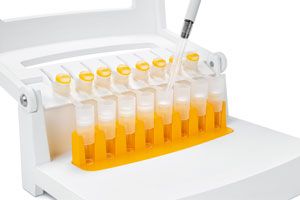Clarification System Enhances Reliable Sample Preparation
The Claristep filtration system from Sartorius improves preparation of samples for analytical testing.
Courtesy of Sartorius.

Preparing samples by clarification is an essential step prior to nearly all analytical techniques, such as high performance liquid chromatography (HPLC). This filtration step to eliminate particles is crucial for maintaining the integrity of chromatography columns and for maximizing their operating lifetime. In addition, as the sensitivity of automated analytical instruments continues to improve, they increasingly require less volume to operate in order to maximize throughput.
Fast, small-volume clarification that does not add leachables or extractables to the original sample is indispensable for achieving the best analytical results. To meet these requirements, Sartorius has developed a straightforward filtration setup, the manually operated Claristep filtration system, consisting of a station and filter units for clarifying samples prior to analysis.
The Claristep station consists of a base, a lid, and an exchangeable tray for easy and accurate positioning of sample vials and Claristep filter units. The patent-pending design features unique grooves in the station’s lid and matching guide ridges on Claristep filter units to enable intuitively correct alignment and convenient handling of the system. The grooves automatically guide the filter unit caps into the correct positions for simultaneous and accurate cap closure.
Claristep enables up to eight samples to be simultaneously filtered, without needing any power supply or a vacuum or pressure source. Single-use Claristep filter units with regenerated cellulose membranes are designed for sample volumes of 60 μL to 600 μL. Their hold-up volume is less than 30 μL. The units have been optimized for solvents and aqueous solutions and provide maximum chemical compatibility as well as low non-specific binding of analytes. The contact time of the samples with the filters and the caps is short, ensuring optimal, contamination-free results. Filtrates are collected in any 12×32-mm outer-diameter vials of the user’s choice based on the analytical method to be performed.
Source: Sartorius
PacBio Chosen as Tech Partner for Global Alzheimer’s Disease Research Project
April 23rd 2025The project, the North African Dementia Registry, will unite multiple entities for the purpose of developing a comprehensive dataset to advance the research community’s understanding of Alzheimer’s disease and other dementias in diverse populations.
Drug Solutions Podcast: A Closer Look at mRNA in Oncology and Vaccines
April 30th 2024In this episode fo the Drug Solutions Podcast, etherna’s vice-president of Technology and Innovation, Stefaan De Koker, discusses the merits and challenges of using mRNA as the foundation for therapeutics in oncology as well as for vaccines.
Pharmaceutical Tariffs Are Imminent: How Industry is Bracing for Impact
April 16th 2025On April 14, 2025, the Trump Administration launched a national security-driven investigation into pharmaceuticals, a move that will likely result in tariffs being placed on pharmaceutical drugs, ingredients, and other components that are imported from outside of the United States.